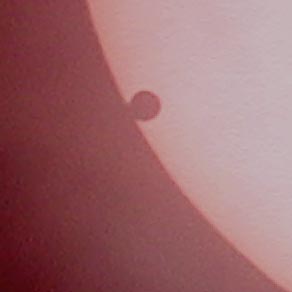Local star gazers stage viewing of rare planetary event
 (CNS): On Tuesday 5 June the planet Venus will transit across the face of the Sun in the late afternoon, an event that happens only once in a lifetime. The second planet from the Sun and Earth’s neighbour won’t make this journey for another 105 years, presenting a unique opportunity to observe a key solar event. In honour of the 21st anniversary of the Cayman Islands Astronomical Society (CIAS), the public is invited to a special viewing of the event, where there will telescopes fitted with specialist solar filters and solar viewing glasses so people can observe the rare sight without damage to their eyes.
(CNS): On Tuesday 5 June the planet Venus will transit across the face of the Sun in the late afternoon, an event that happens only once in a lifetime. The second planet from the Sun and Earth’s neighbour won’t make this journey for another 105 years, presenting a unique opportunity to observe a key solar event. In honour of the 21st anniversary of the Cayman Islands Astronomical Society (CIAS), the public is invited to a special viewing of the event, where there will telescopes fitted with specialist solar filters and solar viewing glasses so people can observe the rare sight without damage to their eyes.
The event will take place on the rooftop of 62 Forum Lane, Camana Bay, from 5 to 7pm where there will also be a small astronomy exhibition. It will take Venus over 6 hours to make its transit across the Sun and it will appear as a ‘dot’ that will cross its surface.
CIAS members intend to take part in a worldwide experiment to time the two points when Venus starts and finishes its journey across the Sun. These two moments in time are not easy to measure experts say; the second moment produces a famous ‘tear drop’ effect, when Venus is at the edge of the Sun’s disk.
Transits of Venus across the Sun were once considered to be of the greatest importance to science and huge efforts were expended trying to record them. After a first attempt to predict the event by Johannes Kepler in 1631, it was first observed eight years later by Jeremiah Horrocks.
For the first time this enabled accurate measurements in astronomical distances to be made, and in particular the distance from the Earth to the Sun. This important ‘yard stick’ is still called the ‘Astronomical Unit’.
Each successive transit attracted world-wide expeditions, including the famous expedition of British explorer James Cook, who was dispatched to Tahiti in 1769 to record the times of this phenomenon. The primary purpose of the expedition was to obtain measurements that could be used to calculate more accurately the distance of Venus from the Sun. If this could be achieved, then the distances of the other planets could be worked out, based on their orbits.
Today, transits are still considered to be important, and recent new techniques will be tested to search for planets in other solar systems.
For residents thinking of observing the Sun from elsewhere, CIAS recommends waiting until close to sunset, when the sun is low on the horizon and safer to observe. Please note: observing the Sun directly (even through a telescope or camera lens) can seriously damage your eyesight – and your camera lens.
Transits of Venus occur in pairs separated by eight years. Each pair is in turn separated by an alternating interval of 105.5 and 121.5 years, making a cycle of 243 years. The last transit of Venus was in June 2004, where modern instruments gave the best views ever and the next transit of Venus will not be seen from Earth until 2117.
For more information, contact chris.cooke@gov.ky or visit Facebook.com/ Cayman Islands
Astronomical Society.
Category: Science and Nature


live feed on http://www.spaceweather.com and also http://www.cnn.com. Use eclipse glasses or use a projection box. You welders, use nothing less than #14 glass. It will be easier to see as the sun approaches sunset.
Safe viewing everyone! Venus is visible now.
Ah, I'll catch it next time
"The third planet from the Sun and Earth’s neighbour"
I believe Venus is the second planet from the sun, Earth is the third
I gather "Third Rock" never made it to Cayman TV?
You've been watching that sitcom "Third Rock from the Sun", haven't you.
HI – it is indeed an event of a lifetime -It will be visible from 5 PM untill Sunset at 7 PM and I do agree with the earlier comments on eye safety. Thats why the Cayman Islands Astronomical Society (CIAS) and Dart have "reserved" a roof top view of the event with free solar vewiing glasses and -in more detail -the public will have chance to look through the Society's solar telescopes with specialist white light and H Alpha filters.
The Worldwide media coverage of this event will get a lot of people interested. The CIAS is keen to show "Science is Fun" and to make sure people see the event safely. And of course we will see it from Cayman
Just to clarify: In this part of the world, the only time the transit of Venus will be visible is at/near sunset. See map: http://eclipse/gsfc.nasa.gov/transit/venus/MAP2012-1,GIF
Please protect your eyes, everybody. It's a once-in-a-lifetime event and something none of us alive today will ever see again.
Sounds like an event not to be missed